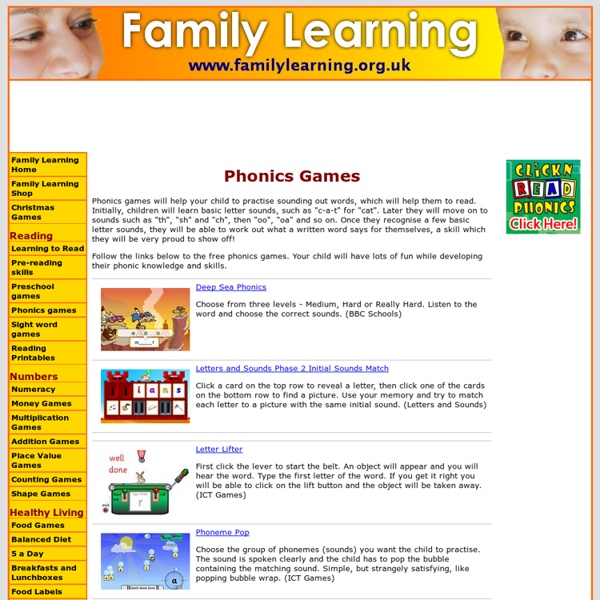Literacy, Foundation
Doorway First Sounds An interactive site which asks what the first sound is of various objects which can be selected first by teachers or parents. English Alphabet The site demonstrates letter formation of all the letters of the alphabet.
Building Language for Literacy
PRIVACY POLICY · Terms of Use · TM ® & © 2017 Scholastic Inc. All Rights Reserved. Teacher's Activity Guide
ESL Kids -Teaching English To Children
HOME: house and furniture Roof, chimney, wall, window, door. Bedroom, bathroom, living-room, kitchen. You can each them words like: bed, chair, table, curtains, basin, towel…etc.
ESL Kids phonics,Sounds Word Building, Reading through Phonics
Main/ Courses / Worksheets / Teaching Tips/ Songs/ Phonics / Flashcards/ Shop / Contact/Partners Phonics Materials for All Games In this section you will find a generous collection of the best phonics resources. There are flashcards, Video slides, Worksheets and more for teachers. KizPhonics.com offers the best Phonics Printables and more. Kiz Phonics is an excellent progressive program for teaching kids to read using a systematic phonics approach.The Kiz Phonics program is carefully arranged by levels from Preschool Ages 3-4, Kindergarten Ages 4 -6, 1st Grade Ages 6-7 & 2nd Grade Ages 7-8.
What is the best way to teach mixed age groups?
Teaching a group of mixed age students can be challenging. But there are many ways that you can work with this situation and have a fun and successful time for all of the students involved. Here are some ideas to get you started. Communicate clearly with parents Let parents know what the goals for the class are and what assistance you will need from them.
Activities for 3 Year Olds – Free Online Activities for Three Year Olds
Plant the seed of a lifelong love for learning in your three-year-old with interesting activities. Simple, easy and fun, JumpStart's activities for three year olds set the foundation for better learning and also help in building their confidence. Check out our fun, free and printable activities to teach the little ones important skills and concepts! How Activities for 3 Year Olds are Beneficial
Playing with Coloured Water - Free, Easy, Educational Fun for Kids
Is there a child who doesn’t love playing with coloured water? This backyard water activity is a super way for kids to learn about colour-mixing, to strengthen fine and gross motor skills, and it’s a terrific way for children to keep cool on a hot, summer day! This water activity is one of our favourites from our collection of simple science activities for toddlers and preschoolers. Ah, good-old water play! What child isn’t happy when they’re playing with water?
salt, glue and watercolour art - happy hooligans - name recognition
A name recognition activity with salt, glue and watercolour art! This was our first time doing salt, glue and watercolour art, and the hooligans and I had so much fun with the process! I used the technique as a tool to help work on letter and name recognition, but it can be used purely as an art project or simple science activity as well. Skill-building and learning:
Melting ice with salt and watercolours - happy hooligans
Melting Ice with Salt and Watercolours – a colourful science experiment for kids. One of the hooligans favourite science activities is melting a block of ice salt and water. Today we’re doing this experiment as a Valentine’s activity so we’ve used a heart-shaped ice block. We’ve done plenty of melting ice experiments before, but this was the first time we’ve included liquid watercolours in the experiment. I’m so glad we did!
How to make your own giant bubbles - bubble recipe
Make the biggest bubbles ever with this homemade giant bubble recipe. Homemade giant bubbles have been on our to-do list for a while, but we were waiting for optimum weather conditions: humid and overcast, with very little wind. Well, yesterday was perfect, so I whipped up this Giant Bubble Mix in the morning and we tried it this afternoon. I am thrilled to report that this bubble recipe really does make the biggest bubbles ever! And, if you’re looking for cool backyard science activities to do with the kids, you can put this at the top of your list!
Easy Puffy Paint recipe
3-Ingredient, homemade Puffy Paint an easy art technique for kids using microwave and a few basic kitchen ingredients. If you know me, you know we LOVE homemade paint recipes and easy science activities. This homemade puffy paint fits the bill perfectly!




Family Learning uses many different games and activities to demonstrate phonics. It targets K-8th grade and keeps students engaged and entertained. by jkor Jul 13
Fun games that allow students to develop their skills in phonics by jortega Mar 13